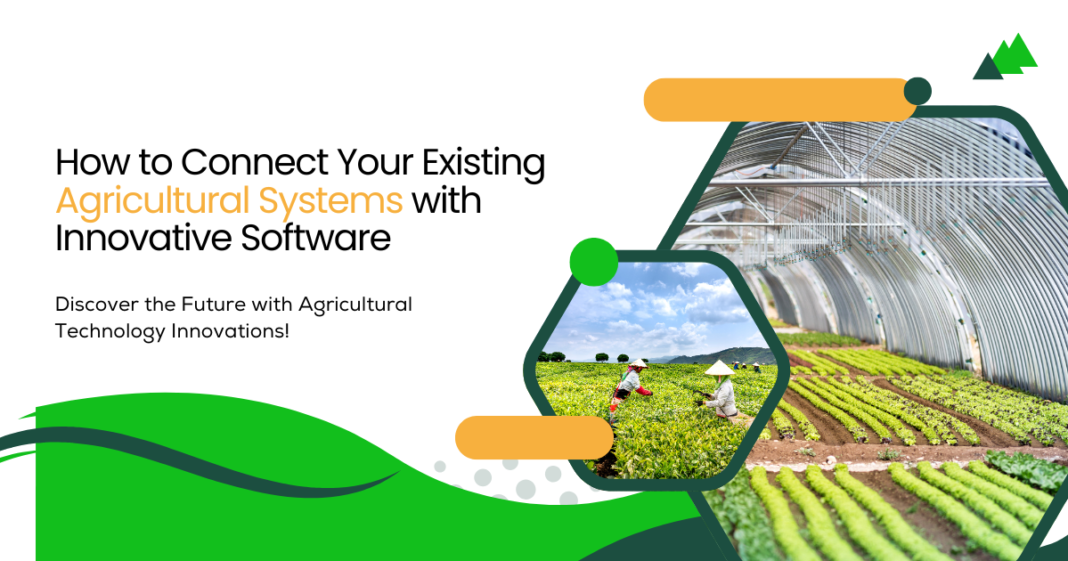Agriculture, the backbone of the global economy, is continually evolving with advancements in technology. In recent years, the integration of innovative agriculture software solutions has become crucial in optimizing farm management, increasing productivity, and ensuring sustainability. While traditional farming methods still play a vital role, connecting existing agricultural systems to modern software can transform how farms operate.
In this article, we’ll explore the benefits of connecting traditional agricultural systems with cutting-edge software, the types of software available, and how to seamlessly integrate them into your existing operations. Whether you’re a small-scale farmer or managing a large agricultural enterprise, this guide will provide you with practical insights for adopting and benefiting from agricultural software.
1. Understanding Agricultural Systems and Software
Before diving into integration, it’s essential to define what constitutes an agricultural system and how software can enhance these processes.
1. Agricultural Systems
Agricultural systems include all the tools, machinery, processes, and workflows involved in farming operations. This could be anything from irrigation systems, crop monitoring, livestock management, to harvest machinery. Many of these systems may already be automated or require manual intervention, and data collection plays a key role in their management.
2. Agricultural Software
Agricultural software encompasses a broad range of solutions that assist farmers in managing their operations. This can include:
- Farm Management Software (FMS): Helps in overseeing operations such as crop management, scheduling, and inventory control.
- Precision Agriculture Tools: Software that analyzes data collected from sensors, drones, and satellite imagery to monitor crop health, soil conditions, and yield forecasts.
- Livestock Management Software: Manages animal health, breeding, and growth tracking.
- Supply Chain and Logistics Platforms: Helps in the distribution and management of harvested crops, ensuring smooth logistics from farm to market.
By integrating these software solutions into your existing agricultural systems, you can gain better control over operations, reduce manual work, improve yields, and save time and costs.
2. Benefits of Integrating Innovative Software into Agricultural Systems
Integrating software with your current agricultural systems has numerous benefits that can transform your farming operations. Some of the key advantages include:
1. Improved Decision-Making
With real-time data at your fingertips, agricultural software can provide insights on weather conditions, soil health, crop growth, and pest threats. This allows you to make more informed decisions on when to plant, irrigate, harvest, or apply fertilizers and pesticides, ultimately leading to better crop yields and resource optimization.
2. Enhanced Efficiency and Productivity
Modern agricultural software can automate many tasks that would otherwise be done manually, such as irrigation management, fertilizer application, and crop monitoring. By automating these tasks, farmers can free up time to focus on more critical aspects of farm management. Moreover, automation can ensure precision farming, where each task is carried out with the utmost accuracy.
3. Cost Savings
Software that enables precision agriculture can significantly reduce input costs, such as water, fertilizers, and pesticides, by applying them only when and where they are needed. Over time, this leads to substantial cost savings and a higher return on investment.
4. Sustainability and Environmental Benefits
Many innovative software solutions are designed with sustainability in mind. By monitoring and analyzing environmental data, farmers can minimize waste, reduce energy consumption, and optimize resource use. This results in more sustainable practices that are beneficial for both the farm and the environment.
3. How to Integrate Software with Existing Agricultural Systems
Integrating software with your existing agricultural systems can seem like a daunting task, but it doesn’t have to be. Here’s a step-by-step guide on how to make the process smoother:
1. Assess Your Current Agricultural Systems
Before integrating any software, evaluate your current systems and operations. Identify which processes are manual, which systems are automated, and where there is potential for improvement. This will help you determine which software solutions are most beneficial for your farm. For example:
- Irrigation Systems: Do you currently rely on manual watering, or do you use an automated irrigation system?
- Farm Equipment: Is your machinery equipped with sensors or GPS for precision farming?
- Data Collection: How do you track crop health, weather, and soil conditions?
2. Choose the Right Software Solutions
Once you have assessed your current systems, it’s time to choose the right software that aligns with your needs. Consider factors such as:
- Scalability: Will the software be able to grow with your farm as it expands?
- Compatibility: Ensure that the software is compatible with your existing agricultural systems (e.g., sensors, machinery).
- User-Friendliness: The software should be intuitive and easy for you and your team to use without requiring extensive training.
- Support and Maintenance: Check whether the software provider offers customer support and software updates.
Some popular agricultural software solutions include John Deere Operations Center, Ag Leader, Trimble Ag Software, and FarmLogs.
3. Invest in Necessary Hardware
In many cases, you will need to equip your existing agricultural systems with new hardware to facilitate the integration. This might include adding sensors, GPS trackers, or drones for crop monitoring. For instance, if you are adding precision irrigation technology, you may need soil moisture sensors and weather stations.
4. Establish Data Connectivity
To enable real-time data sharing between your systems and the software, ensure that your farm has reliable internet connectivity. This could mean installing Wi-Fi or using mobile data to transmit data from field sensors to the cloud-based software platform.
5. Train Your Team
Once the software and hardware are in place, it’s important to train your team on how to use them effectively. Training should focus on how to collect data, interpret reports, and utilize the software to make decisions. Having a skilled workforce that understands how to use the system is crucial for maximizing its potential.
6. Monitor and Evaluate the Results
After integrating the software into your agricultural operations, continually monitor the system’s performance. Evaluate whether it’s helping you achieve the desired results in terms of efficiency, productivity, and cost savings. If needed, make adjustments or upgrade your systems to improve performance.
4. Agricultural Software Development Companies: Partnering for Success
If your farm needs custom solutions, or if you want to integrate several systems, you might consider working with an agriculture software development company. These companies specialize in creating tailored software that meets the specific needs of farmers and agricultural businesses. Partnering with such a company can help you:
1. Get Custom Solutions
A custom agricultural software development company can design a platform that integrates all your systems, whether it’s for crop management, livestock tracking, or supply chain management. Instead of using generic software, custom solutions are tailored to your farm’s unique processes and requirements.
2. Improve Integration
An experienced agriculture software developer can ensure that your existing systems, whether they are old equipment or new technology, are seamlessly integrated with the new software. This reduces the complexity of managing multiple systems and ensures smooth data flow across different platforms.
3. Focus on Long-Term Support
Many agricultural software development companies offer ongoing support and maintenance services. This is crucial in ensuring that the software continues to operate smoothly, receives timely updates, and can adapt to future technologies or agricultural advancements.
4. Stay Ahead of Technological Advancements
A good agriculture software development company will keep you up-to-date with the latest trends in precision agriculture, machine learning, AI-driven analytics, and other cutting-edge technologies. This allows your farm to stay competitive and future-proofed as technology continues to evolve.
Some reputable agricultural software development companies that offer custom solutions include AgriWebb, Ag Leader Technology, and Trimble Ag Software. They provide services ranging from farm management solutions to advanced precision agriculture tools.
5. Overcoming Challenges in Integration
While the benefits of connecting agricultural systems to innovative software are clear, there are challenges that may arise during the integration process. Here are some common challenges and how to overcome them:
1. Initial Costs
The upfront costs of purchasing software, sensors, and other required hardware can be significant. However, consider this as a long-term investment that will pay off through increased productivity and cost savings. Many software providers offer flexible pricing plans or financing options to ease the burden.
2. Technical Issues
Integrating new software with existing agricultural systems may lead to technical glitches or compatibility issues. It’s important to work closely with software vendors or technology consultants to troubleshoot and resolve any problems.
3 Data Security
With the increasing use of cloud-based platforms, data security is a valid concern. Ensure that the software you choose offers robust data encryption and secure access controls to protect sensitive farm data from unauthorized access or cyberattacks.
4. Resistance to Change
Adopting new technologies may face resistance from staff who are used to traditional farming methods. Overcome this by providing adequate training, demonstrating the benefits of the system, and involving your team in the decision-making process.
6. Future of Agricultural Software Integration
The future of agricultural software integration looks promising, with continuous advancements in artificial intelligence (AI), machine learning, drones, and Internet of Things (IoT) technology. These innovations will provide even more sophisticated tools for farm management, offering enhanced capabilities for predictive analytics, automated operations, and personalized farming solutions.
As agricultural software continues to evolve, it will become even more essential for farmers looking to stay competitive and achieve sustainable growth. By connecting your agricultural systems with innovative software, you will be well-equipped to face the challenges of modern farming and position your farm for long-term success.
Also Read: Affordable Enterprise Mobile App Development Services
7. Conclusion
Integrating innovative software with your existing agricultural systems is no longer a luxury; it’s a necessity for those looking to optimize farm management, improve yields, and enhance sustainability. By carefully selecting the right software, equipping your systems with the necessary hardware, and providing proper training to your team, you can take full advantage of the benefits of digital farming. Whether you choose off-the-shelf solutions or partner with an agriculture software development company for a custom solution, the result will be a more efficient, productive, and sustainable agricultural operation that can thrive in an increasingly technology-driven world.




